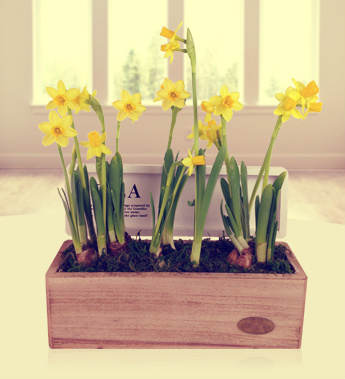
How To Care For Potted Daffodils
Caring for potted plants can be a bit of a trick if you have not done the right research in advance. By reading up and consulting with experts, you will be fully prepared to create the ideal environment and conditions for your new potted plant. Daffodils are part of the genus Narcissus and they make wonderful gifts for many occasions. While many choose to send flowers for Mother’s Day, for example, others prefer a gift that will last longer than cut stems and give the recipient even more joy over a period of time. If you are considering buying potted Daffodils as a gift or if you are the lucky recipient, then continue reading for some handy care tips.

Temperature and sunlight
In the beginning, if you receive a very young plant, you will want to ensure that the room temperature is dimly lit and somewhere between 10 and 15 degrees Celsius until the growing shoots are green. Your potted Daffodil should be kept away from direct sunlight and any type of heat source. So, keep it far from heaters, fire places and so on. The heat causes the plant to bloom more rapidly and, while this can feel very rewarding at first, it actually shortens the lifespan of the plant.
After the first week, or if your potted Daffodil already has green shoots, then you can place the plant in a brighter, slightly warmer room. They like temperatures that range between 15 and 21 degrees Celsius but you should still avoid keeping them in close proximity to any kind of heat source or direct sunlight.
Soil
The best soil for your potted Daffodil is sandy soil. If you order a potted Daffodil from your local florist or nursery, it should certainly come in just the right pot with the right type of soil too. It is, however handy to know what to look for when making your selection. The sandy soil allows for faster water drainage so do ensure that you place a saucer underneath the pot to catch excess water.
Water
You should only water your potted Daffodil when you notice the soil is getting dry. Pour approximately one quarter cup of water over the soil at a time. Wait until the water has had a chance to filter through the soil before you add any more water. When you notice some water drain into the dish below, you should stop watering immediately and monitor the soil every day. Do not let the soil become too dry but also avoid over watering. With sandy soil, the excess water will just drain out anyway.
Other information
It’s very important to understand the nature of every house plant you bring home. All Narcissus plants contain a certain toxin called lycorine. It is found in the bulbs and the leaves of the plant and can cause various reactions if consumed.
Florists also report cases of dermatitis associated with handling Daffodils. The calcium oxalate in the sap of the plant is believed to be the culprit so, if you want to play it safe, you should always wear gardening gloves when working with these plants and do everything in your power to keep them out of reach of children and pets.
